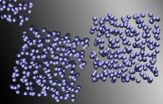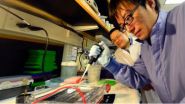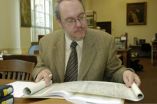(Press-News.org) Some experiments are really difficult to perform in practice. To gain a detailed understanding of the behaviour of molecular hydrogen (H2), for example, we would have to produce such high pressures as those occurring within the core of gaseous planets like Jupiter and Saturn or inside stars. If such conditions cannot be created, an alternative method is to simulate them on the computer, but the model has to be accurate. A group of research scientists from the International School for Advanced Studies (SISSA) in Trieste used a simulation model that is far more accurate than previously used, and carried out an experiment to test a hypothesis about the behaviour of hydrogen that is splitting the scientific community.
"We developed this simulation method here at SISSA over the past ten years", explains Sandro Sorella, a SISSA professor and co-author of the paper. "It's a highly accurate technique based on the quantum Monte Carlo method – a family of algorithms but usually limited to a small number of particles – that we have developed in order to consider now a large number of atoms, and obtain an almost realistic situation. A great advantage".
"We used the simulation to verify the Wigner and Huntington prediction", adds Guglielmo Mazzola, from SISSA and first author of the paper.
In 1935 Eugene Wigner and Hillard Bell Huntington conjectured that at very high pressures, when hydrogen makes the transition from the "molecular" phase to the "atomic" phase (when the atoms are so close to each other that the molecular structures can no longer be distinguished), hydrogen acquires metallic properties.
"In recent years, attempts to verify this hypothesis both theoretically and experimentally have yielded conflicting results with regard to the pressure required to achieve 'metallization'", comments Mazzola. "Our simulation, in the liquid phase, showed that we might indeed be very far from being able to observe this transition experimentally. According to our findings, metallization can only take place at pressures approaching 500 gigapascal. This is an enormous value, which only occurs in the innermost layers of gaseous planets and cannot be achieved with currently available experimental equipment".
"A detailed understanding of the phase diagram of hydrogen", concludes Sorella, "is not only important for studies in the field of astrophysics, but also for learning how this element behaves and, for example, under what conditions it becomes a superconductor".
INFORMATION:
The research was conducted in collaboration with the advanced research institute AICS-Riken in Tokyo, which provided the computational resources of one of the most powerful supercomputers in the world, the K-computer.
Like being inside a star
A simulation to observe how hydrogen behaves at very high pressures
2014-03-24
ELSE PRESS RELEASES FROM THIS DATE:
Pioneering research offers new insight into improved wave energy testing
2014-03-24
Pioneering research could provide a significant boost in the vital quest to harness wave power as a viable renewable energy source for the future.
Scientists from the University of Exeter have studied how wave energy developers can more accurately measure, and predict the wave conditions within wave energy test sites.
The research, which is published in leading scientific journal Energy, deployed wave measurement buoys and used wave modelling to show how variations in wave size and strength could be resolved.
The results should aid developers to better predict sea ...
Maturitas publishes position statement on management of vertebral osteoporotic fracture
2014-03-24
Amsterdam, March 24, 2014 – Elsevier, a world-leading provider of scientific, technical and medical information products and services, today announced the publication of a position statement by the European Menopause and Andropause Society (EMAS) in the journal Maturitas on the topic of the management of postmenopausal women with vertebral osteoporotic fracture.
Vertebral osteoporotic fracture is an underestimated condition as only about a third of people with the disease seek medical attention. While it may cause acute back pain, the presentation may be insidious with ...
Protein called YAP gives blood vessels strength, shape
2014-03-24
AUGUSTA, Ga. - A protein known to promote cancer appears to give the blood vessels strength and shape, researchers report.
When yes-associated protein, or YAP, is deleted from vascular smooth muscle cells during development, the protein makes thin-walled blood vessels that over-dilate in response to the usual pressure of blood flow, said Dr. Jiliang Zhou, vascular biologist at the Medical College of Georgia at Georgia Regents University.
"The thickness of the arterial wall decreases from three or four layers of smooth muscle cells to one or two layers," said Zhou, corresponding ...
From mouse ears to man's?
2014-03-24
One in a thousand children in the United States is deaf, and one in three adults will experience significant hearing loss after the age of 65. Whether the result of genetic or environmental factors, hearing loss costs billions of dollars in healthcare expenses every year, making the search for a cure critical.
Now a team of researchers led by Karen B. Avraham of the Department of Human Molecular Genetics and Biochemistry at Tel Aviv University's Sackler Faculty of Medicine and Yehoash Raphael of the Department of Otolaryngology–Head and Neck Surgery at University of ...
Guarding grapes and other tales from papyri
2014-03-24
If you weren't careful, you might end up beaten by grape thieves skulking in the darkness.
A University of Cincinnati graduate student writes about the contractual obligations of vineyard guards and researchers from around the world contribute more stories from ancient times in the most recent volumes of the Bulletin of the American Society of Papyrologists (BASP).
UC's Peter van Minnen, associate professor of classics, has edited the international journal since 2006. BASP is an annual collection of articles and reviews pertaining to important discoveries from around ...
Lots of carbon dioxide equivalents from aquatic environments
2014-03-24
Large amounts of carbon dioxide equivalents taken up by plants on land are returned to the atmosphere from aquatic environments. This is the conclusions from a study carried out by two students at Linköping University, Sweden.
As students at the Master program Science for Sustainable Development in Linköping, Bala Panneer Selvam and Sivakiruthika Natchimuthu, did a thorough investigation of greenhouse gas emissions from many types of inland waters in India under supervision by Dr Lakshmanan Arunachalam, Tamil Nadu Agricultural University, India, and Dr David Bastviken, ...
A towel less: How psychologists harness sociability to cut waste
2014-03-24
Hotel guests can be gently persuaded to reduce the number of towels they use each day, psychology researchers at the University of Luxembourg have found. With fewer towels to wash, this reduces the waste of water, energy and detergent. This is good news for the environment and it cuts costs, so enabling hotels to reduce prices.
Two hotels in Swiss and Austrian ski resorts helped with an experiment in early 2013. Three different signs were placed separately in different bathrooms, all of which gently reminded guests of the environmental impact of towel use. However, one ...
Microfluidic device with artificial arteries measures drugs' influence on blood clotting
2014-03-24
A new microfluidic method for evaluating drugs commonly used for preventing heart attacks has found that while aspirin can prevent dangerous blood clots in some at-risk patients, it may not be effective in all patients with narrowed arteries. The study, which involved 14 human subjects, used a device that simulated blood flowing through narrowed coronary arteries to assess effects of anti-clotting drugs.
The study is the first to examine how aspirin and another heart attack prevention drug respond to a variety of mechanical blood flow forces in healthy and diseased arteries. ...
Would you believe your hand could turn into marble?
2014-03-24
This news release is available in German.
The study was published in the international scientific journal PLOS ONE on 13 March 2014.
To induce an illusory perception of the material properties of the hand, a group of neuroscientists from Bielefeld University, the Max-Planck Institute for Biological Cybernetics (Germany), and the University of Milano-Bicocca (Italy) asked volunteers to sit with their hands lying on a table in front of them. They repeatedly hit the participants' right hands gently with a small hammer while replacing the natural sound of the hammer ...
Hot nanoparticles for cancer treatments
2014-03-24
This news release is available in German. If you put your hand over a switched-on torch in the dark, it appears to glow red. This is because long-wavelength red light beams penetrate human tissue more effectively than short-wavelength blue light. ETH Zurich researchers exploit this fact in a new kind of nanoparticles: so-called plasmonic particles, which heat up when they absorb near-infrared light. This could enable them to kill tumour tissue with heat, for instance.
Gold is a popular material for nanoparticles used therapeutically, as it is well tolerated and ...
LAST 30 PRESS RELEASES:
Making lighter work of calculating fluid and heat flow
Normalizing blood sugar can halve heart attack risk
Lowering blood sugar cuts heart attack risk in people with prediabetes
Study links genetic variants to risk of blinding eye disease in premature infants
Non-opioid ‘pain sponge’ therapy halts cartilage degeneration and relieves chronic pain
AI can pick up cultural values by mimicking how kids learn
China’s ecological redlines offer fast track to 30 x 30 global conservation goal
Invisible indoor threats: emerging household contaminants and their growing risks to human health
Adding antibody treatment to chemo boosts outcomes for children with rare cancer
Germline pathogenic variants among women without a history of breast cancer
Tanning beds triple melanoma risk, potentially causing broad DNA damage
Unique bond identified as key to viral infection speed
Indoor tanning makes youthful skin much older on a genetic level
Mouse model sheds new light on the causes and potential solutions to human GI problems linked to muscular dystrophy
The Journal of Nuclear Medicine ahead-of-print tip sheet: December 12, 2025
Smarter tools for peering into the microscopic world
Applications open for funding to conduct research in the Kinsey Institute archives
Global measure underestimates the severity of food insecurity
Child survivors of critical illness are missing out on timely follow up care
Risk-based vs annual breast cancer screening / the WISDOM randomized clinical trial
University of Toronto launches Electric Vehicle Innovation Ontario to accelerate advanced EV technologies and build Canada’s innovation advantage
Early relapse predicts poor outcomes in aggressive blood cancer
American College of Lifestyle Medicine applauds two CMS models aligned with lifestyle medicine practice and reimbursement
Clinical trial finds cannabis use not a barrier to quitting nicotine vaping
Supplemental nutrition assistance program policies and food insecurity
Switching immune cells to “night mode” could limit damage after a heart attack, study suggests
URI-based Global RIghts Project report spotlights continued troubling trends in worldwide inhumane treatment
Neutrophils are less aggressive at night, explaining why nighttime heart attacks cause less damage than daytime events
Menopausal hormone therapy may not pose breast cancer risk for women with BRCA mutations
Mobile health tool may improve quality of life for adolescent and young adult breast cancer survivors
[Press-News.org] Like being inside a starA simulation to observe how hydrogen behaves at very high pressures




